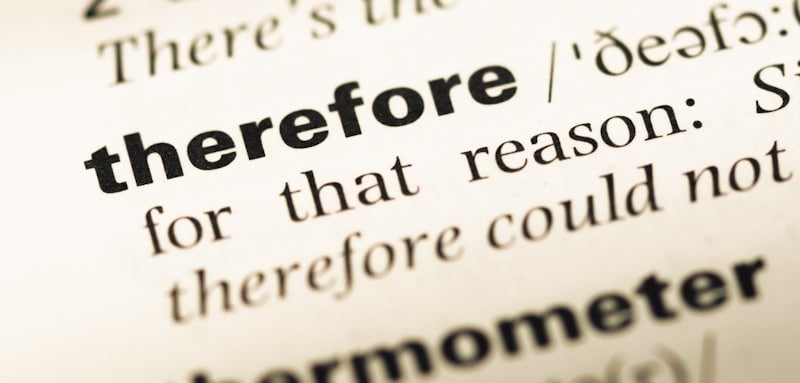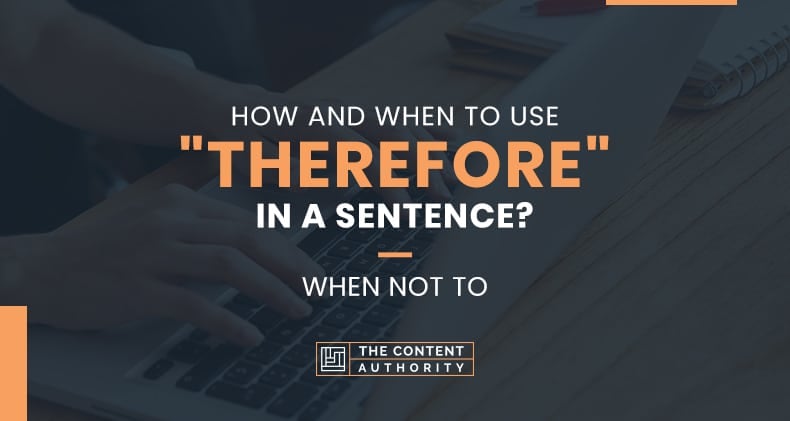The adverb “therefore” can be quite tricky to use in texts. Since it can be used to conjoin two sentences, it often gets misconstrued for a coordinating conjunction – which it is not. So, how and when to use “therefore” in a sentence?
The term “therefore”, like “hence” and “thus”, is used in texts as an interrupter or to connect two independent clauses. The adverb signifies “something happens due to something else”. However, unlike a coordinating conjunction, it needs a semicolon preceding it to adjoin two proper sentences.
There are quite a few things to consider when incorporating “therefore” in sentences. Not adhering to even one of those rules could render a sentence grammatically wrong. Keep reading to learn more about how and when to use “therefore” in texts and everything else.
“Therefore” – Meaning
The adverb “therefore” doesn’t have a proper definition as such. But it roughly means “consequently”, “for that reason”, “because of that”, etc.
Besides the words above, some other terms that “therefore” replaces in texts include:
- As a result
- Hence
- To that end
- Thus
- Thereupon
All of the above words/phrases, like “therefore”, introduce a statement caused by, or stemming from, what precedes immediately.

Are “Therefore” and “Therefor” the Same?
Like “therefore”, “therefor” is an adverb, but it denotes “for it” or “for that”.
Contrary to general perception, “therefor” is not an invalid term or the misspelling of “therefore”. But because it’s seldom used in prose, it’s not as familiar as it should or could be. Not to mention, “therefore” and “therefor” cannot be interchangeably used in texts.
Here are a couple of sentences using “therefor” to help you understand the term better and its usage in texts:
- Terrence has had multiple agreements therefor since then.
- Since it’s a quasi-public firm, it should offer its services to everyone that applies therefor.
Incorporating “therefor” in texts can be confusing, thanks to its visual similarity with “therefore”. Also, “for it” can seamlessly blend into the sentences above in place of “therefor”, which further adds to the perplexity.
Using “Therefore” in Texts
“Therefore” is used in texts to connect two different thoughts that can or cannot be expressed in two individual sentences. Though the word seems to work like a conjunction, it doesn’t belong to the category of terms that “but” and “and” are a part of. It’s essentially an adverb that does conjunctive adverb duties. For example:
- December is the month of festivities; therefore, it’s the period of gifts.
When “therefore” is used to bring together two sentences, a semicolon should always precede it – unlike coordinating conjunctions that use a comma instead. In other words, the following is an incorrect use of “therefore”:
- The new hires were trained in a week, therefore they were put on live projects only after a week.
The above sentence can be corrected by using “and” instead.
- The new hires were trained in a week, and they were put on live projects after a week.
The sentence could keep “therefore” and could be written as either of the following:
- The new hires were trained in a week; therefore, they were put on live projects after a week.
- The new hires were trained in a week. Therefore, they were put on live projects after a week.
The second sentence above also illustrates how “therefore” can be used at the beginning of a sentence.
However, using “therefore” to start a new paragraph is not considered correct or ideal since a section starts afresh and doesn’t usually need a backstory or context. When using “therefore” as the first term in a sentence, you must preface the text.
That said, some writers do use “therefore” to begin a sentence and manage to get away with that.
When used in the middle of a sentence, “therefore” concludes things, or it indicates the reason why a specific point was made. For example:
- He was not happy with the software update situation on his phone. I, therefore, advised him to purchase a new smartphone but not from the same manufacturer.
In the passage above, if the first sentence is taken out, the reader will not understand why the subject is talking about buying a new smartphone. The original sentence offers some much-needed context.
As mentioned above, “therefore” is used in texts as a conjunctive adverb. It’s not a coordinating conjunction like some people wrongly think. Also, unlike “but” and “and”, “therefore” and other conjunctive adverbs are not often used in everyday conversations. It’s used mainly in prose.
“Therefore” can be used in the middle of a sentence with or without commas or any form of punctuation. “But” and “and”, on the other hand, require a “comma” or “period” before them. But when “but” or another conjunction is not used to join clauses, it doesn’t require punctuation around it. For example:
- I like him, but I do not like his friend.
- I like him but some of his strange habits.
Similar is the tale with “therefore”—more on the usage of commas or punctuations with “therefore” below.

Using Punctuation with “Therefore”
The term “therefore” usually has a comma(s) in its immediate vicinity – whether the word is at a sentence’s beginning or somewhere in the middle. For example:
- Therefore, it makes a lot more sense not to invest in a particular stock.
- It could, therefore, mean hoping a lot from a single transaction.
It’s also acceptable to use “therefore” without parenthetical commas. The meaning or the structure of the sentence won’t be affected due to the lack of commas. For example:
- You should therefore clarify things with her now.
- This would foster competition and therefore much better deals for the end consumer.
Such usage, however, is usually relegated to casual or friendly correspondences. Or when “therefore” is not meant to serve as some kind of an interrupter.
As briefly discussed earlier, if “therefore” brings together two independent clauses or “therefore” is used as a conjunctive adverb, it’s preceded with a semicolon (;). For example:
- She reached the place late; therefore, she had to wait.
- He worked ward throughout the year; therefore, he received the promotion.
- She is my teacher; therefore, I respect her, even if I do not agree with some of her views.
Some people may choose to replace the semicolon with a colon in the sentences above, which is undoubtedly incorrect.
Using “Therefore” in Oral Conversations and Punctuations
The use of parenthetical commas may look correct on paper or in written texts. But if it were to be analyzed from the “oral speech” perspective, the two commas may seem one too many or unnecessarily interruptive.
In other words, when “therefore” has two punctuation marks on its sides (be it a semicolon and a comma, or a couple of commas), it denotes two distinct pauses. When reading the sentence aloud or using “therefore” in regular oral communications, however, the two verbal delays do not exist. There’s only a brief breather before “therefore”, which may also not get emphasized at times.
Commas warrant a minor but noticeable pause in delivery. In public, trying to read a sentence containing “therefore” with its customary commas will sound awkward and even affectatious.
The pause is okay to employ when you’re in a courtroom or on a stage. But if you use those audibly discernible pauses when talking to your colleague or at the grocery counter, the other person is sure to give you the “what’s wrong with you?” look.
Long story short, punctuations flanking “therefore” on both sides are fine in texts if they do not intend to represent or reflect “normal” dialogue accurately.

Example Sentences with the Term “Therefore”
The following are sentences incorporating the word “therefore”. Though some of them may require context, the sentences are grammatically correct, nonetheless.
- His narrative, therefore, was considered incomplete.
- Ingesting vitamin D3 supplements, therefore, can help with muscle building and overall good health.
- Those were just figures taken from a small population. The actual number could, therefore, be significantly higher.
- Therefore, he was not too keen on the offer.
- The best defense, therefore, is offense.
- Greek yogurt has higher protein content compared to regular yogurt. It, therefore, tends to be a bit more filling.
- You, therefore, should be wary of where you buy your supplements.
- This makes her feel healthy and, therefore, more energetic at work.
- The decision to appoint him as a trustee, therefore, makes sense.
- Therefore, a lot more houses should be built.
- She can, therefore, now afford to be a lot more philosophical about the defeat that hurt her big time then.
- He, therefore, doesn’t qualify to talk about the benefits of temperance.
- It’s, therefore, imperative to move on to the next task at hand right away.
- She is down with fever and, therefore, will not be playing tomorrow.
- She worked on the piece for six hours at a stretch; therefore, she could finish it before the deadline.
- The rebels killed all the tourists that were coming through the particular road during the last few weeks. She, therefore, urged us not to take that route and even abort the travel if there was no alternate path.
Conclusion
To conclude, “therefore” can be quite complex to incorporate in sentences – that is, if you don’t know what the adverb means or represents.
Though the meaning is relatively easy to learn and imbibe, things become quite tricky when punctuations, particularly commas, have to be accounted for. Since it’s okay not to use commas when there usually should have been a pair, quite a few writers find themselves stranded, unsure of using commas.
As mentioned above, don’t skimp on the punctuation if it’s a formal text. Some amount of slack is, however, acceptable if the scenario is more casual or friendly.
Shawn Manaher is the founder and CEO of The Content Authority. He’s one part content manager, one part writing ninja organizer, and two parts leader of top content creators. You don’t even want to know what he calls pancakes.

